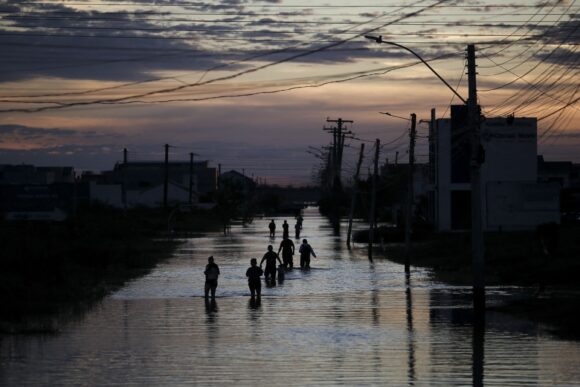Greenhouse gases produced by human activity made the recent deadly flooding in Brazil twice as likely as it would have been in the preindustrial era, according to a rapid analysis of the event by World Weather Attribution (WWA), an international research initiative.
Rio Grande do Sul, Brazil’s southernmost state, is in a rainy, subtropical climate zone. But the precipitation of up to 543 millimeters (21 inches) that fell in some areas between April 26 and May 5 was almost unprecedented, WWA researchers say. Flooding affected more than 90% of the state, leaving at least 172 people dead.
Factors besides climate change — such as poor flood-control infrastructure and deforestation — played a role in making the floods more destructive. But it was the interplay between climate change and El Niño, the occasional warming of the eastern equatorial Pacific, that dramatically heightened the likelihood of the precipitation as well as its intensity.
“Climate change is amplifying the impact of El Niño in southern Brazil by making an extremely rare event more frequent and intense,” Regina Rodrigues, a researcher at the Federal University of Santa Catarina and one of 13 scientists who collaborated on the climate attribution study, said in a statement.
The frequency and intensity of extreme rain events are increasing worldwide as temperatures climb, the Intergovernmental Panel on Climate Change has found. For every 1C increase in temperature, air can hold about 7% more water.
Brazil’s floods continued well after the period covered by the WWA analysis; by the end of May, nearly 600,000 people had been forced to leave their homes. The WWA scientists focused on a 10-day period because it included the severest rain. They compared current air and sea temperatures to historical averages to model the impact of burning fossil fuels.
Combustion of fossil fuels increased the likelihood of the extreme rainfall by a factor of two, and the rain’s intensity by 6% to 9%. In the current climate (which has warmed 1.2C), an event such as this is expected to happen once every 100 to 250 years — that is, rarely. But if global warming exceeds 2C, the likelihood will be twice what it is now.
Maja Vahlberg, a climate risk consultant at Red Cross Red Crescent Climate Centre, said in a statement that governments need to be better prepared for such disasters in a warming world. “Implementing policies that make people less vulnerable, increasing protection against floods and restoring natural ecosystems to buffer the impact of heavy rains are some ways by which governments can avoid human deaths and limit the damage,” she said.
Photograph: People walk along a flooded street in Eldorado do Sul, Brazil, on May 9, 2024; photo credit: Anselmo Cunha/AFP/Getty Images
Topics Flood Climate Change
Was this article valuable?
Here are more articles you may enjoy.



 QBE to Non-Renew $500M of North American Mid-Market Biz
QBE to Non-Renew $500M of North American Mid-Market Biz  Allstate, Nationwide Post Dramatic Q12024 Homeowners Loss Ratio Drops: S&P
Allstate, Nationwide Post Dramatic Q12024 Homeowners Loss Ratio Drops: S&P  Cyber Insurance Market ‘Stable’ With Potential for Growth, Says AM Best
Cyber Insurance Market ‘Stable’ With Potential for Growth, Says AM Best  Big ‘I’ Report: Independent Agency Channel Placed 62% of Premiums in 2023
Big ‘I’ Report: Independent Agency Channel Placed 62% of Premiums in 2023 

